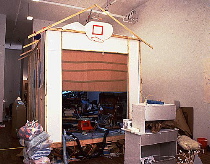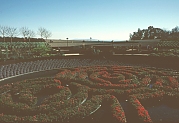
Ever since the commotion about Frank Gehry’s Guggenheim Bilbao [see image] I’ve been thinking about the funny state of sculpture. It seems to me that architecture like Gehry’s big box has always represented some of the best sculpture around (Parthenon, Coliseum, Notre Dame, etc.) so I don’t really get why people attack Gehry for doing what architects seem to want to do naturally. (Of course there is that money thing, but let’s hold that discussion for another day.)
So I accept that Gehry’s way, art done by architects, is one car on the sculpture highway. An SUV perhaps but so what. What about everybody else?
Looking around, it seems that the impulse to make sculpture has gotten sidetracked by the impulse to mess around with materials and by an academic mindset that has everybody making work about “boundaries” or the second law of thermodynamics.
What happened to just plain old let’s make an object (just one) that a human viewer can relate to and put it in a space and let the viewer relate. Let’s bring back statues for crying out loud.  Let’s turn the whole enterprise over to artists like Diana Moore or Jeanne Jaffe, two object makers who seem to keep the viewer in mind. [see figure by Diana Moore]
Let’s turn the whole enterprise over to artists like Diana Moore or Jeanne Jaffe, two object makers who seem to keep the viewer in mind. [see figure by Diana Moore]
Anything wrong with that?
I used to hate installation art. I thought it would be the death of sculpture. Most of it (Pepon Osorio’s “No Crying in the Barber Shop” is an exception) was self-indulgent, bloated and self-satisfied. And the installation enterprise took sculpture out of the realm of object-making and into the land of high concept room decoration. (Jason Rhoades for example. [see “Garage Renovation New York,” 1993 below).
Time passes and things change. New installation art by Sarah Sze, our own Astrid Bowlby and others turn installation into something more hand-made and somehow in keeping with sculptural object-making. It’s viewer-friendly installation. It’s great. Is this a way forward for sculpture? Many, tiny, hand-made things that crawl up walls and around pillars; accruals and assemblages that have a micro-approach instead of a macro?
 Another nail in sculpture’s coffin, it seems to me, is the public art initiatives, most of which turn 3-D objects into million-dollar benches (Vito Acconci at the Philadelphia International ) or landscaping (Robert Irwin’s gardens at Getty Museum [see image]). I’d rather not sit on my sculpture, thanks anyway. How about it sculptors, how and where’s it going?
Another nail in sculpture’s coffin, it seems to me, is the public art initiatives, most of which turn 3-D objects into million-dollar benches (Vito Acconci at the Philadelphia International ) or landscaping (Robert Irwin’s gardens at Getty Museum [see image]). I’d rather not sit on my sculpture, thanks anyway. How about it sculptors, how and where’s it going?









